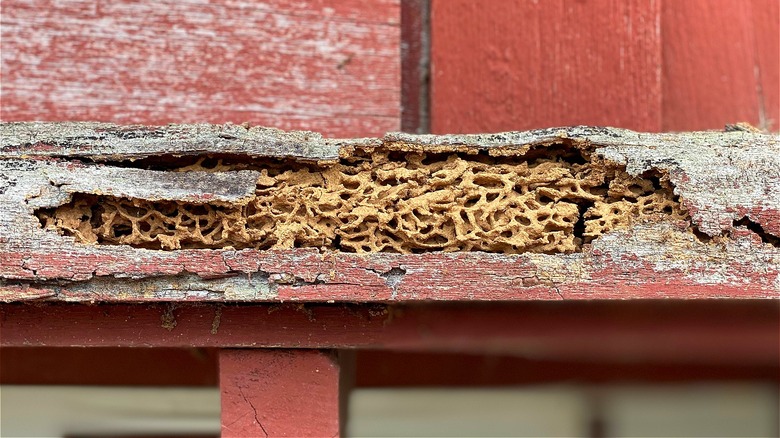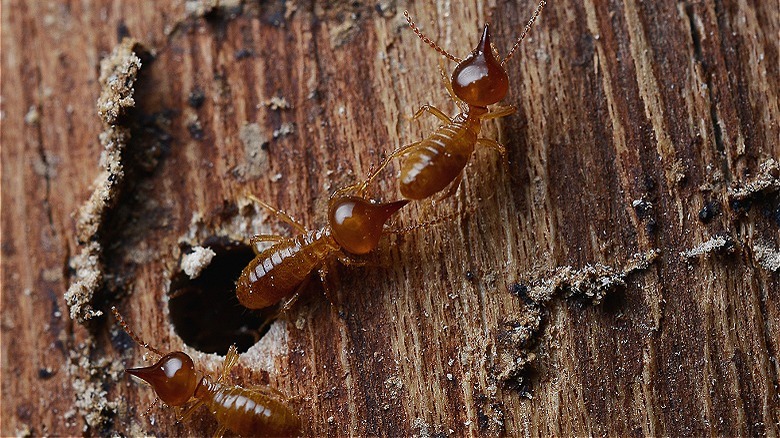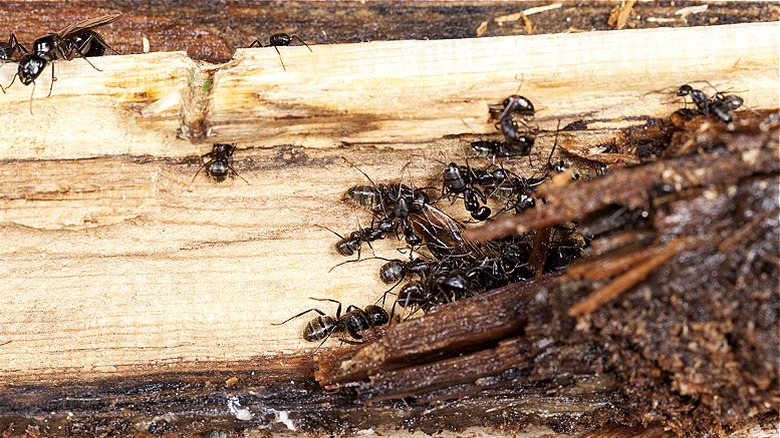Termites Vs. Carpenter Ants: How To Tell Which Pest Is Damaging Your Property
The wood felt sturdy last time you checked, but now it's hollow and compromised. Before you sink into despair and look for ways to get rid of termites, step back and reinspect the damaged property — are termites (Isoptera) responsible for this, or are carpenter ants (Camponotus) at play? Given how, at first glance, these ants can pass off as termites, as they are sized, shaped, and colored similarly — although some might interject that the latter is slightly smaller — it's difficult to conclude who the real property saboteur is. However, looking at the pesky invaders and their infestation signals can clear up the picture.
While both household pests share an appetite for your property, carpenter ants — in keeping with their name — chew the wood with their saw-like jaws without eating it and push out the woody remnants, or frass, to create smooth nesting galleries. In contrast, termites eat out the wood, hollowing it completely and giving it a sunken look (see above). They also leave behind mud tubes and cast-off wings.
Spotting stealthy termites on property
Despite the uncanny resemblance, termites differ significantly from carpenter ants, showcasing their behavior. While it isn't easy to notice them in your home, as they rarely wander outside their nesting sites unless swarming, you can tell if they've been silently gnawing at your wood from certain telltale signs. Healthy or moist, termites nest in and voraciously eat all kinds of wood, which sounds hollow when knocked. Their subterranean variety is fond of creating mud tubes that function as safe passages. They also drop 1-millimeter wide, brown, rounded pallets under the damaged wood, clearly signaling their presence. During spring, you may find discarded swarmer wings near doors and windows.
Physically, you can differentiate termites from ants by their waists and wings. These silent destroyers have rectangular bodies without cinching in the middle and straight, bead-like antennae. Moreover, they have two pairs of paddle-shaped, translucent or creamy wings, which, although sized equally, are relatively longer than their body's mere ⅜ inches. Based on species type, termites appear brown or black to the eye. Suffice it to say that termites are far more damaging than black ants, and controlling them requires professional assistance.
Recognizing damage from carpenter ants
Unlike termites, carpenter ants are partial to moist wood, especially those found around bathtubs, skylights, windowsills, wall voids, and more, because they're easier to chew. They don't consume the lumber, preferring to dig it inside out to create nesting tunnels, which are far smoother and cleaner than what termites achieve. They then create holes in wood to throw out the wood shavings.
Moreover, being foragers, ants make their presence felt by roaming around your home in search of sugary foods. They also make peculiar, rustling sounds, especially at night, which give away their nest's location. Like termites, they leave behind droppings, too. However, these are shaped irregularly and contain insect carcasses, soil, and sawdust.
Appearance-wise, carpenter ants have slender bodies, pinched clearly at the waist, and carry elbowed (bent) antennae on their heads. While they support two wing pairs, their pointy front wings are larger than the hind wings, unlike the equally sized termite swarmers. Also, they aren't as delicate. While mostly black, some red varieties of carpenter ants do exist. Of the two pests, these are far less damaging, but you should get rid of carpenter ants by physically removing their nests or using insecticides.


